WhatsApp Marketing Strategies for D2C Brands: Unlock Growth with TheBotmode
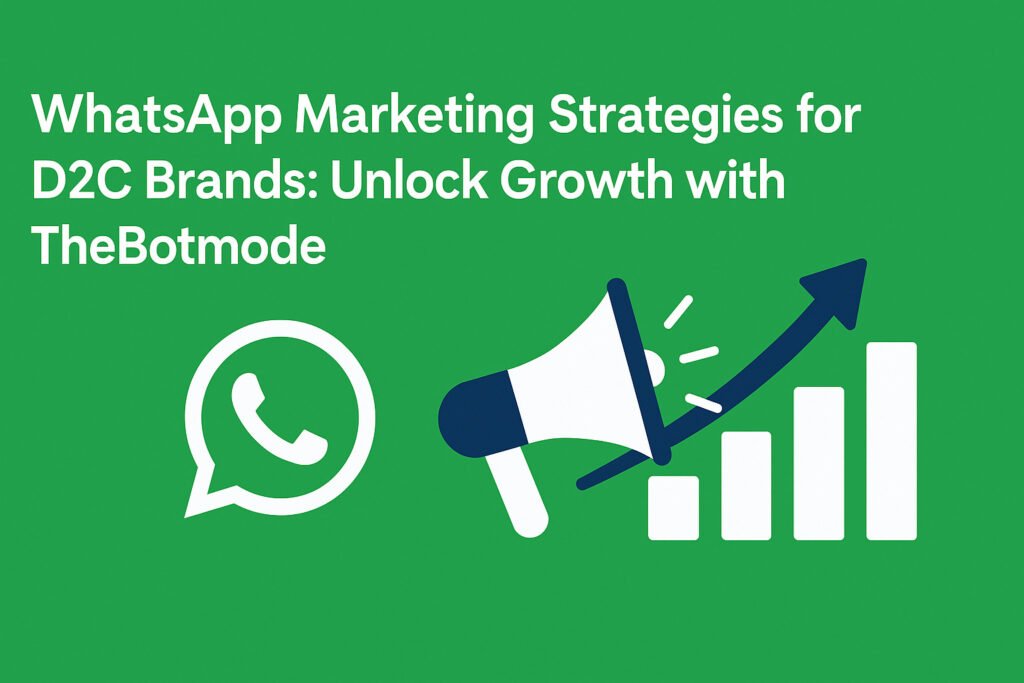
WhatsApp has evolved far beyond a simple messaging app. With over 2 billion users, it is now an essential tool for businesses to connect, engage, and convert customers. For D2C (Direct-to-Consumer) brands, WhatsApp Marketing is not just an option—it’s a powerful channel to drive meaningful customer relationships and increase sales. At TheBotmode, we specialize in helping businesses unlock the full potential of WhatsApp Marketing through innovative strategies designed to deliver real results. In this guide, you’ll discover powerful WhatsApp Marketing strategies to elevate your brand’s communication, drive customer engagement, and boost ROI. What is WhatsApp Marketing for D2C Brands? WhatsApp Marketing is a form of direct messaging that allows D2C brands to communicate with their customers via WhatsApp. It involves sending personalized promotional messages, updates, reminders, customer support, and even processing orders—all within a single app. Using features like the WhatsApp Business API, automated chatbots, and broadcast messaging, businesses can scale communication while maintaining a personal touch, which is crucial for D2C brands aiming for higher customer engagement. Why WhatsApp Marketing is Essential for D2C Brands Whether you’re a startup or an established enterprise, WhatsApp Marketing strategies can help you create authentic relationships with your customers, improve retention, and drive measurable results. Top WhatsApp Marketing Strategies That Actually Work for D2C Brands 1. Use WhatsApp Business API for Scalability For D2C brands looking to handle thousands of messages daily, the WhatsApp Business API is a game-changer. It enables automation, integrates seamlessly with your CRM, and supports chatbot functionality. At TheBotmode, we help you set up and manage the API effortlessly, ensuring that your brand can scale communication without losing its personal touch. 2. Set Up Automated WhatsApp Chatbots Don’t let your customers wait. AI-powered chatbots engage leads instantly, answer FAQs, and even guide users through the sales funnel 24/7. This strategy is crucial for lead nurturing and customer support, allowing D2C brands to keep customers engaged and satisfied. 3. Segment and Personalize Your Broadcast Lists Avoid sounding like spam by segmenting your audience based on behavior, location, or purchase history. Personalized broadcast messages see higher engagement and conversions. Tailor your message for each segment, ensuring your communication feels relevant and timely. 4. Leverage Interactive Buttons & Quick Replies Make your messages more actionable by adding clickable buttons, product catalogs, and quick replies. These interactive features not only improve the user experience but also boost CTR (Click-Through Rates), encouraging customers to take action immediately. 5. Integrate WhatsApp With Your Website & Ads Add Click-to-WhatsApp buttons on your website or run Facebook/Instagram ads that open directly in WhatsApp. This seamless transition helps improve conversions and simplifies lead capture, making it easier for customers to reach out and inquire about products or services. How TheBotmode Helps with WhatsApp Marketing At TheBotmode, we provide end-to-end WhatsApp Marketing services tailored to your business goals. Whether it’s chatbot setup, campaign management, API integration, or analytics, we’ve got you covered. Our platform is user-friendly, scalable, and backed by a team of marketing professionals who live and breathe WhatsApp Marketing strategies. We work with you to implement effective strategies, track performance, and continuously optimize your campaigns for better results. FAQs Q1. Is WhatsApp Marketing Legal? Yes, WhatsApp Marketing is legal as long as you obtain user consent before messaging and follow WhatsApp’s commerce policy. It’s important to comply with WhatsApp’s guidelines to avoid account suspension. Q2. Can Small D2C Businesses Use WhatsApp Marketing? Absolutely! Small D2C businesses can use the WhatsApp Business App or API to easily reach their audience and enhance customer communication. Q3. What Types of Messages Can I Send via WhatsApp Marketing? You can send a variety of messages, including order updates, promotions, product catalogs, reminders, surveys, and customer service messages. The key is to keep the content personalized and relevant to the recipient. Q4. How is TheBotmode Different from Other WhatsApp Marketing Platforms? TheBotmode stands out with its user-friendly dashboard, powerful automation tools, and expert support. We provide a no-code platform that allows business owners and marketers to manage campaigns without a technical background. Q5. Do I Need a Developer to Use TheBotmode? Not at all! Our platform is designed to be no-code, making it accessible to marketers and business owners without the need for technical expertise. Our team is also available to offer support whenever needed. Conclusion: Start Your WhatsApp Marketing Journey Today WhatsApp Marketing offers a huge opportunity for D2C brands to enhance engagement, streamline customer service, and boost conversions. With TheBotmode by your side, you can easily implement these powerful strategies, scale your communication, and achieve your marketing goals. Ready to unlock the power of WhatsApp Marketing? Start growing your business today with TheBotmode!
Meta’s New WhatsApp Pricing Explained: What It Means for Your Brand
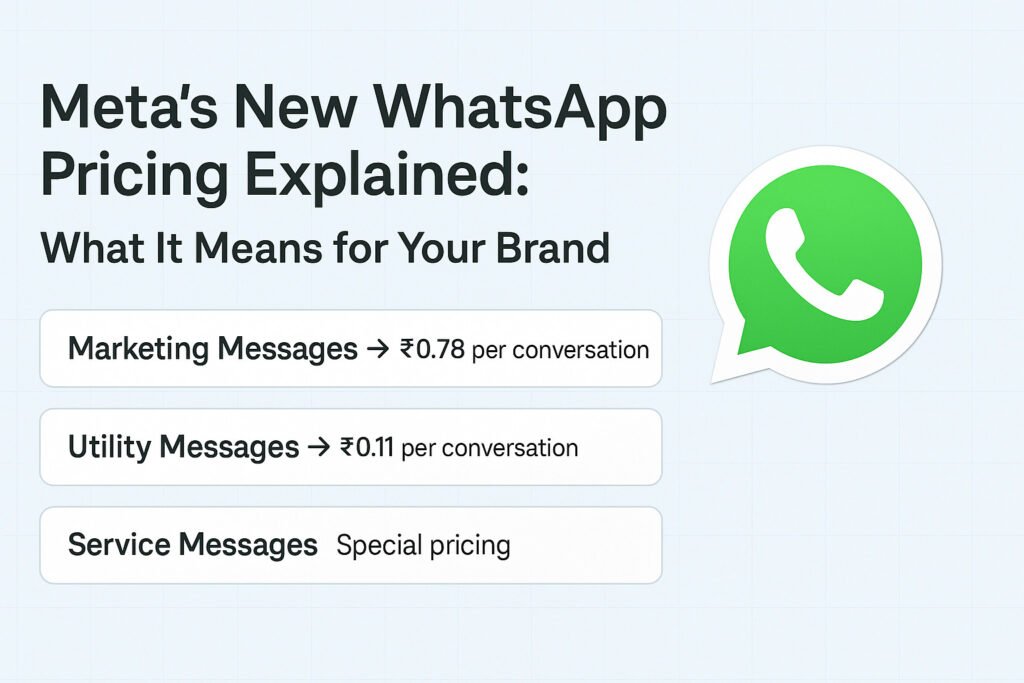
Introduction WhatsApp has become the go-to channel for D2C brands and eCommerce businesses. But as usage grows, Meta continues to refine its WhatsApp Business API pricing model. In July 2025, Meta announced new pricing changes that directly impact how brands plan customer engagement and marketing campaigns. If you’re running WhatsApp for customer support, cart recovery, or promotions, understanding these updates is critical for managing ROI. Let’s break it down in simple terms. WhatsApp Pricing 2025: What Changed? Meta now categorizes conversations into different types, each with a specific charge per conversation (usually 24 hours long). Example (India Market – July 2025): (Pricing varies by country and by partner platforms.) What This Means for Your Brand Strategies to Manage WhatsApp Costs in 2025 Global Impact: Not Just India While pricing numbers differ across regions, the overall pattern is consistent: marketing conversations cost more, utility conversations are cost-effective. D2C brands worldwide must adjust communication strategies to align with these updates. Conclusion Meta’s new WhatsApp pricing update is not a setback but a shift toward smarter engagement. By leveraging automation, personalization, and cost-effective transactional messaging, D2C brands can maintain strong ROI while managing costs. In 2025, WhatsApp remains the most powerful channel for direct-to-consumer commerce. The brands that adapt quickly to the new pricing model will continue to win. FAQs Q1. What is the new WhatsApp pricing in India (2025)? As of July 2025, marketing messages cost ₹0.78 per conversation, while utility messages cost ₹0.11 per conversation. Q2. What counts as a marketing conversation? Any promotional or sales-driven message, such as offers, discounts, or new product launches, falls under marketing. Q3. What counts as a utility conversation? Transactional updates such as order confirmations, delivery notifications, or COD verifications are considered utility messages. Q4. How long does one WhatsApp conversation last? Meta defines a conversation window as 24 hours from the first message sent by the business. All replies within this window are included in the same charge. Q5. How can D2C brands reduce WhatsApp costs? By segmenting campaigns, prioritizing utility messages, sending messages at the right time, and working with a transparent Business Solution Provider.
How D2C Brands Can Deliver Post-Purchase Delight via WhatsApp
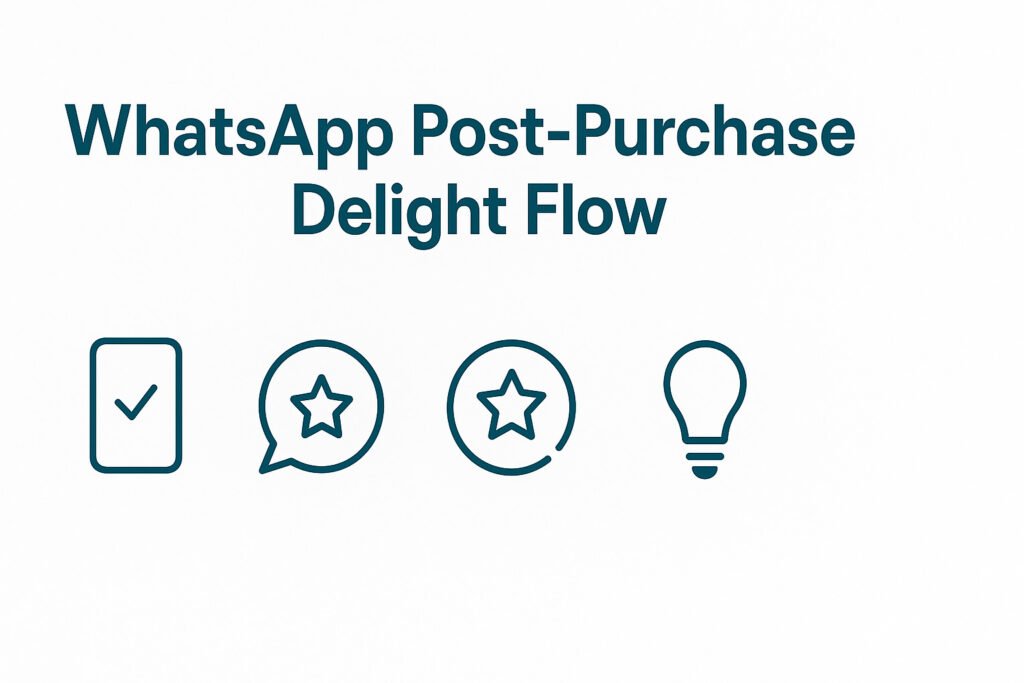
Introduction For Direct-to-Consumer (D2C) brands, the customer journey doesn’t end when a purchase is made — it truly begins there. The post-purchase experience determines whether a one-time buyer becomes a repeat customer or disappears forever. In 2025, WhatsApp has emerged as the most powerful tool for delivering post-purchase delight. With instant communication, high open rates, and interactive features, brands can turn every delivery into a chance to build loyalty. 1. Real-Time Order & Delivery Updates Problem: Customers often feel anxious after placing an order, wondering when it will arrive.Solution: Automate order confirmation, shipping, and delivery updates through WhatsApp. Example: A luxury chocolate brand in London sends updates at every stage: Why it works: Reduces “Where’s my order?” support queries and builds trust. 2. Post-Delivery Thank You & Feedback Collection Problem: Many brands fail to engage after delivery, missing a loyalty-building opportunity.Solution: Send a thank you message and a quick feedback survey via WhatsApp within 24 hours of delivery. Example: A skincare D2C brand in Mumbai sends: “Hey [Name], we hope you’re loving your new product! Could you rate your experience? Why it works: Customers feel valued, and you collect real-time feedback for improvement. 3. Loyalty & Rewards Programs Problem: Loyalty emails often get ignored.Solution: Introduce loyalty perks directly inside WhatsApp. Example: A UAE-based activewear brand sends a WhatsApp loyalty card image showing points balance and exclusive offers. 4. Product Usage Tips & Cross-Sell Suggestions Problem: Customers don’t always know how to get the best results from their purchase.Solution: Share how-to videos, care guides, and complementary product suggestions. Example: A coffee subscription brand in New York sends a video on “How to Brew the Perfect Cup” and recommends a premium grinder. 5. Post-Purchase Customer Support Problem: Post-purchase support via email is slow and impersonal.Solution: Offer instant chat support via WhatsApp for returns, replacements, or usage queries. Example: A beauty brand in Delhi uses a WhatsApp AI bot to instantly answer FAQs and connect customers to a human agent if needed. Conclusion Delivering post-purchase delight is about making customers feel cared for beyond the sale. WhatsApp gives D2C brands the tools to: The brands that master this in 2025 will not just sell — they’ll create superfans.
How to Use WhatsApp to Drive COD to Prepaid Orders
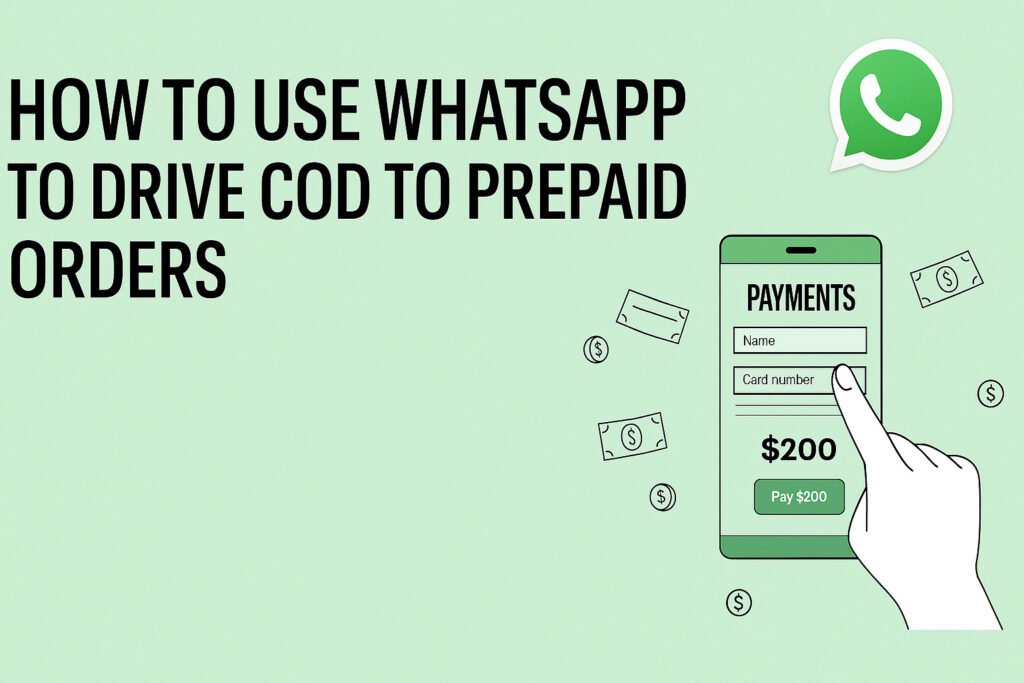
Introduction For most D2C brands, Cash on Delivery (COD) orders are a big part of sales. They make purchasing easier for customers, but they also come with challenges—higher Return to Origin (RTO) rates, delayed cash flow, and wasted shipping costs. Every cancelled COD order impacts profits. One of the smartest ways to solve this is by converting COD orders into prepaid. When done right, this not only reduces RTO but also ensures smoother cash flow. WhatsApp automation can make this process simple, fast, and scalable. This guide explains how to use WhatsApp to convert COD orders into prepaid orders effectively. 1. Why Convert COD to Prepaid Orders? Before we talk about strategies, let’s look at the main benefits: 2. Using WhatsApp to Convert COD to Prepaid a) Send Automated Payment Links When a COD order is placed, send an automated WhatsApp message with a secure payment link. Mention the advantages, such as faster delivery or a small discount, to encourage payment. Example: Hi [Name], thank you for your order! Pay online now and get 5% off plus faster delivery. Your secure payment link: [Link] b) Offer Instant Discounts or Freebies Give customers a small reason to pay upfront. For example: These can be shared instantly through automated WhatsApp flows after the order is placed. c) Create Urgency with Limited-Time Offers A time limit pushes customers to act quickly. For example:Complete your payment within 6 hours and get free express shipping. d) Build Trust with Secure Payment Communication Mention trusted gateways like Razorpay, PayU, or Paytm in your messages. If possible, use your verified WhatsApp Business account with the green tick to boost confidence. e) Send Follow-Up Reminders If the payment isn’t made right away, send reminders: 3. Using WhatsApp Automation Platforms With tools like TheBotMode, you can: 4. Tips to Increase Conversion Rates Conclusion Switching customers from COD to prepaid is not just about saving money—it’s about making your order process more reliable and profitable. WhatsApp automation can help you do this efficiently by sending quick payment links, offering small rewards, and following up at the right time. With the right approach, you can increase prepaid orders, reduce RTO losses, and improve cash flow. TheBotMode can set up your entire COD-to-prepaid system in just a few days, helping your brand scale faster and more profitably.
Optimize COD Orders: Drive Prepaid Adoption via WhatsApp and Reduce RTO
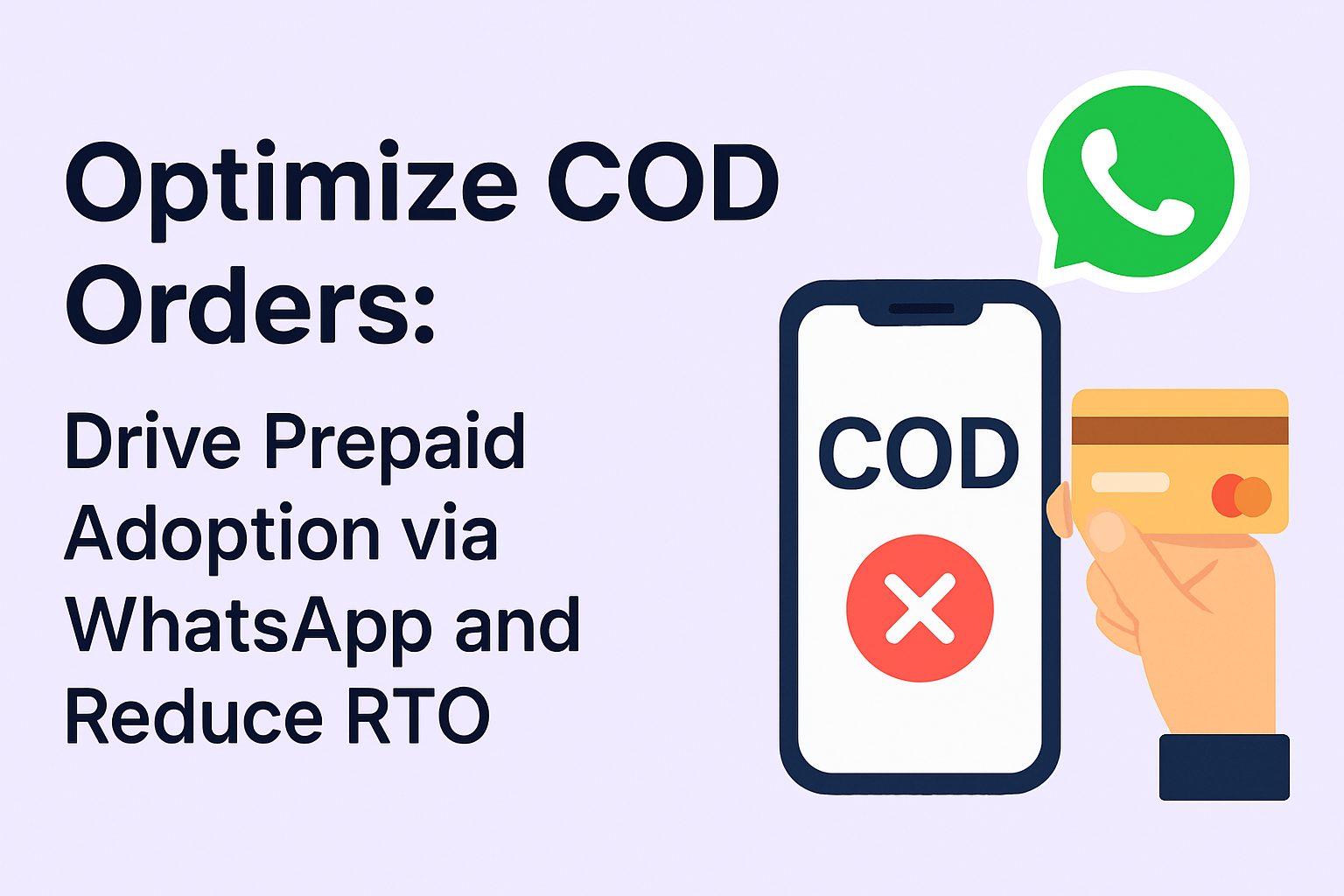
Introduction Cash-on-Delivery (COD) has long been the preferred payment method in India’s e-commerce ecosystem, especially for Direct-to-Consumer (D2C) brands. However, the convenience it offers customers often comes at a high operational cost: Return to Origin (RTO). RTO not only results in lost sales but also increases logistics expenses, warehouse load, and product damage risks. Today, forward-thinking D2C brands are leveraging WhatsApp Marketing, COD verification techniques, and NDR (Non-Delivery Report) workflows to convert cash-on-delivery orders to prepaid, significantly reducing RTO. This blog will guide you on how to do just that. What is RTO, and why does COD make it Worse Return to Origin (RTO) occurs when an order is shipped but fails to reach the customer, prompting its return to the seller. With COD orders, RTO rates are 2–3x higher than prepaid orders due to: These issues not only delay order cycles but also eat into profit margins. Why COD Orders Fail: Key Triggers Missed deliveries, unverified addresses, and lack of customer intent are among the top reasons COD orders fail. Often, customers place COD orders impulsively with no real intention to complete the purchase. By failing to validate customer intent, brands set themselves up for higher RTOs and operational inefficiencies. WhatsApp Marketing: A Game-Changer for COD-to-Prepaid Conversion Why WhatsApp Works for D2C Brands WhatsApp isn’t just a support channel—it’s a conversion machine when used strategically. NDR Management: Stop RTO Before It Happens Understanding NDRs Non-Delivery Reports (NDRs) are triggered when a delivery attempt fails. Timely NDR resolution helps brands avoid automatic returns and gives another chance to salvage the sale. COD Verification: Filter Out Low-Intent Orders Verification Tools That Work Brands using verification have reported up to a 35% reduction in fake or frivolous COD orders. Boost Engagement Before Delivery Use interactive tools to build a relationship with the buyer pre-delivery: Performance Metrics to Track Keep an eye on these metrics: These KPIs will inform you whether your strategy is reducing RTO effectively. Conclusion Reducing RTO and converting COD to prepaid isn’t just about saving costs—it’s about optimizing customer experience, improving cash flow, and scaling sustainably. By combining WhatsApp marketing, COD verification, and smart NDR management, D2C brands can significantly boost prepaid adoption while maintaining operational efficiency. FAQs What is the biggest reason for high RTO in COD orders? Unverified buyer intent and fake orders are the leading causes. How much RTO can WhatsApp marketing reduce? Brands have seen up to a 30% reduction when using automated WhatsApp workflows. Is NDR management only useful for COD orders? While it’s crucial for COD, it also helps recover failed prepaid deliveries with a better customer experience. What tools help automate COD verification and NDR management? Platforms like The Bot Mode, Interakt, and Gupshup offer full-stack WhatsApp automation for D2C needs.
WhatsApp Order Alert: Automate Order Processing and Notifications

WhatsApp Order Alert: Automate Order Processing and Notifications Introduction In today’s fast-paced ecommerce landscape, direct-to-consumer (D2C) brands need to deliver not just products but also instant and reliable communication. Delays in order updates often lead to frustrated customers, increased support tickets, and lost trust. The solution? WhatsApp Order Alerts—automated notifications that keep your customers informed every step of the way. This blog explores how automated WhatsApp messages can streamline order processing, reduce overhead, and dramatically improve the post-purchase experience for your customers. What Is a WhatsApp Order Alert? A WhatsApp Order Alert is an automated notification sent to a customer via WhatsApp whenever a specific stage of their order is completed. These alerts can cover everything from order confirmation, payment verification, processing, shipping, and delivery. Unlike traditional channels like SMS or email, WhatsApp offers real-time updates, rich media formats, and interactive elements like buttons and tracking links—all while maintaining open rates above 95%. Key Stages of Automated WhatsApp Order Flow Order Confirmation As soon as a customer places an order, a WhatsApp message confirms receipt with order details. This builds instant trust and reduces buyer anxiety. Order Processing Notification Once payment is verified or the item is prepared for dispatch, send a status update to keep your customer in the loop. Shipping / In Transit Notify your customer that their package has been shipped. Include the tracking link or live status updates via WhatsApp. Out for Delivery A message sent on the day of delivery ensures your customer is ready to receive their order, minimizing failed attempts. Delivered Confirm successful delivery and include a call-to-action for feedback, ratings, or future offers. Benefits for D2C Brands 1. Increased Open Rates & Engagement WhatsApp messages see 98%+ open rates, far outperforming emails or SMS. This ensures critical order information is never missed. 2. Builds Trust and Transparency Real-time updates enhance customer trust and make your brand appear more professional and reliable. 3. Reduces Support Queries Automated updates dramatically cut down “Where is my order?” (WISMO) inquiries, saving your support team valuable time. 4. Opportunity for Upselling and Feedback You can include personalized product suggestions, catalog links, or ask for reviews, all within your WhatsApp alerts. 5. More Cost-Effective Than SMS No per-message SMS charges or carrier fees. WhatsApp also allows media, links, and interactivity—better ROI. Conclusion A seamless order experience can make or break a D2C brand’s reputation. With automated WhatsApp order notifications, you deliver not only the product but also peace of mind, one alert at a time. From order confirmation to delivery, these messages boost transparency, reduce support overhead, and build long-term customer loyalty. 👉 Ready to get started?Explore our step-by-step WhatsApp Order Alert solution here:Set Up WhatsApp Notifications Now › FAQs Q1: Do I need consent before sending WhatsApp order alerts? Yes. Customers must opt in before receiving business-related WhatsApp messages. Q2: Can I include tracking links and images in WhatsApp alerts? Absolutely. WhatsApp allows links, product images, PDFs, and CTA buttons. Q3: What does it cost to send WhatsApp alerts? It depends on your BSP and location, but it’s usually lower than SMS and offers more functionality. Q4: Is the WhatsApp Business App enough, or do I need the API? For automation, you’ll need the WhatsApp Business API, not just the basic app.
How to Sell Directly on WhatsApp Using Product Catalogs
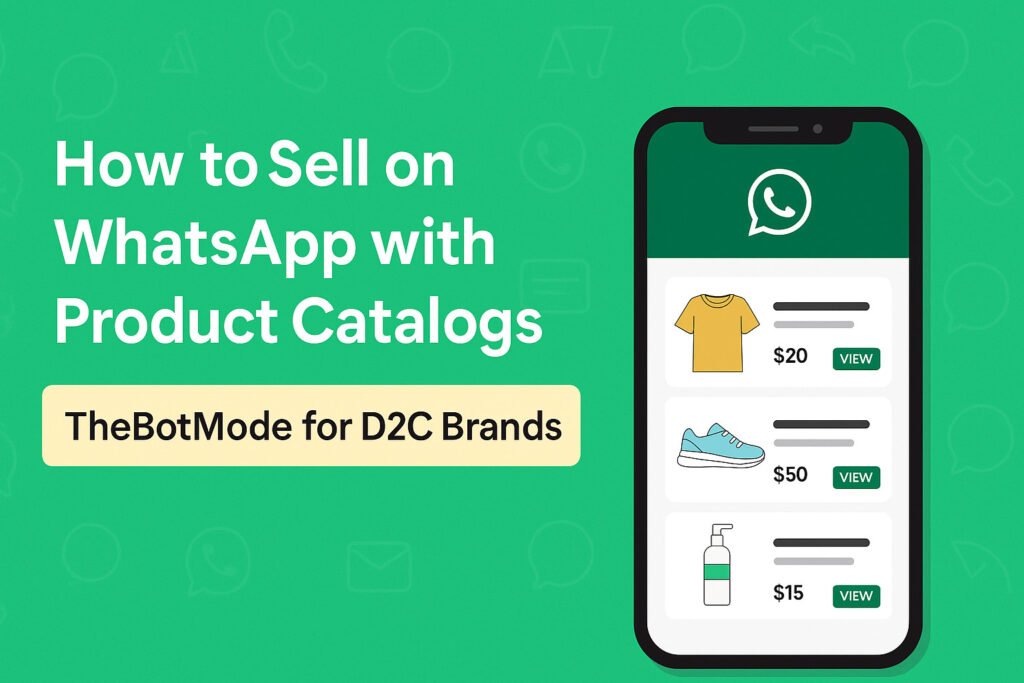
WhatsApp for D2C Brands Is Not Just Messaging In today’s fast-moving D2C world, convenience drives conversion. With over 2 billion users globally, WhatsApp is no longer just a messaging app—it’s a full-fledged commerce channel. Thanks to WhatsApp product catalogs, brands can now showcase products, receive orders, and even collect payments—all within a single chat thread. In this blog, we’ll explore how D2C brands can sell directly on WhatsApp using product catalogs—and how platforms like TheBotMode make this seamless and scalable. What Is a WhatsApp Product Catalog? A WhatsApp product catalog acts as a mobile storefront inside your business profile. It allows you to display product images, pricing, descriptions, and purchase links—all within WhatsApp. Customers can browse your products and add items to their cart without leaving the app, reducing friction and increasing the likelihood of purchase. Why D2C Brands Should Use WhatsApp Product Catalogs Faster Purchase Decisions In-chat browsing reduces drop-offs and decision fatigue. Zero Learning Curve No new apps or websites—WhatsApp is already familiar to your audience. Higher Engagement Product discovery and conversations happen in one place. Wider Geo-Reach From metros to Tier 3 towns, WhatsApp is where your customers are. Lower CAC By selling directly, you reduce reliance on ads and third-party marketplaces. How to Set Up a WhatsApp Product Catalog 1. Choose the Right WhatsApp Business Tool 2. Create Your Catalog 3. Organize with Categories Group similar items together (e.g., T-Shirts, Footwear, Skincare) to make browsing easier. 4. Share Products in Chat When chatting with a customer, tap the “attachment” icon → Catalog → Select product to send it instantly. TheBotMode Advantage: Supercharge Your WhatsApp Storefront While WhatsApp’s native features are useful, TheBotMode turns your catalog into a powerful D2C sales machine. Auto-sync catalogs from Shopify, WooCommerce, or custom websitesAI-driven recommendations based on user chat behaviorCart & Checkout functionality within WhatsAppPayment gateway integration (Razorpay, Stripe, etc.)Multi-agent support for high-volume teamsOrder tracking and post-sale automation Tips to Maximize Sales with WhatsApp Catalogs Use Quick Replies for FAQs (e.g., shipping, returns, sizes)Leverage Broadcasts to announce new arrivals or offersAutomate Reminders for users who viewed products but didn’t purchaseTrack Engagement to identify best-selling or low-performing productsPersonalize suggestions based on past interactions or preferences Turn WhatsApp Into Your Top D2C Sales Channel WhatsApp product catalogs are a game-changer for D2C brands seeking to streamline the shopping experience. With platforms like TheBotMode, you can go beyond a basic catalog and build an automated, intelligent, and conversion-optimized commerce experience—right inside WhatsApp. If you’re ready to turn conversations into conversions, now is the time to integrate your product catalog and start selling where your customers already are. FAQs Q1. Can I connect my Shopify store with WhatsApp catalogs? Yes! TheBotMode enables auto-sync of your Shopify product listings directly to WhatsApp via the Business API. Q2. Is WhatsApp Catalog available in all countries? Yes, it is available globally. However, features may vary slightly depending on the region. WhatsApp catalogs are widely supported in India, Southeast Asia, the Middle East, and Latin America. Q3. Can customers place orders directly on WhatsApp? Yes. With Business API automation, you can allow product
Recover Lost Sales from Abandoned Carts
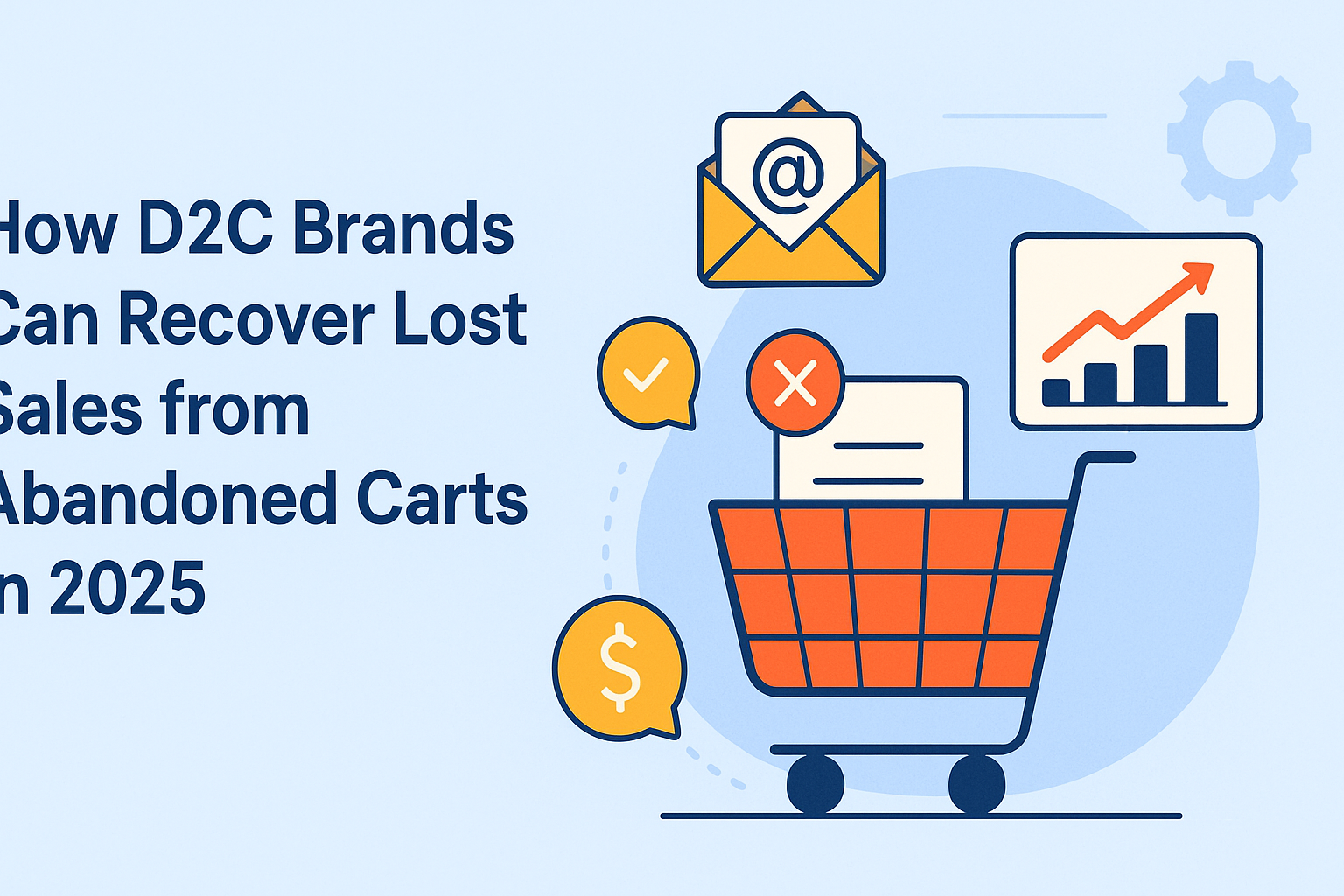
How D2C Brands Can Recover Lost Sales from Abandoned Carts in 2025 Introduction Cart abandonment is a persistent issue plaguing D2C brands. In 2025, with consumer expectations evolving and competition rising, simply getting shoppers to your checkout page isn’t enough. Direct-to-consumer (D2C) brands must proactively combat abandoned carts using modern, personalized recovery strategies. Fortunately, cutting-edge automation tools like The Bot Mode make this easier than ever—helping you recover lost revenue with precision and speed. Understanding Cart Abandonment in 2025 Why D2C Brands Face Higher Abandonment Rates Key Cart Abandonment Stats to Know in 2025 Top Abandoned Cart Recovery Tactics That Work Smart Email Automation Workflows Email remains the foundation of cart recovery. In 2025, top-performing brands utilize: Leveraging SMS & WhatsApp for Immediate Conversions SMS and WhatsApp cut through the clutter and get instant attention. Exit-Intent & Retargeting Popups Use exit-intent technology to catch abandoning visitors before they leave: The Tech Stack D2C Brands Need in 2025 Automation Platforms Like The Bot Mode Using automation is no longer optional—it’s mission-critical. The Bot Mode empowers brands to: Choosing the Right Analytics Tools To continuously improve cart recovery: Best Practices to Maximize Recovery Rates Timing, Segmentation & Offers Testing & Optimization Cycles Real-World Examples of D2C Cart Recovery Success Mini Case Study: Boosting Cart Recovery by 35% Using WhatsApp Automation A D2C brand implemented WhatsApp reminders via The Bot Mode with: 📈 Result: 35% cart recovery boost in 30 days. Common Pitfalls to Avoid Conclusion In 2025, abandoned cart recovery is a key revenue lever for every D2C brand. With advanced tools like The Bot Mode, email, SMS, and WhatsApp automations, and a data-driven approach, your brand can convert lost carts into loyal customers. 👉 Ready to reduce your cart abandonment rate? Start automating with The Bot Mode today. FAQ Section Q1: What is the best way to recover abandoned carts for D2C brands in 2025? The best approach includes multichannel automation—email, SMS, WhatsApp—combined with personalization, offers, and precise timing. Q2: Do abandoned cart emails still work in 2025? Yes, when personalized and timely. They’re even more effective when paired with SMS or WhatsApp reminders. Q3: How many messages should I send to recover an abandoned cart? Typically 3–4 messages across 72 hours perform best: one right after abandonment, one follow-up, and a final offer. Q4: Can WhatsApp really help with cart recovery? Absolutely. WhatsApp’s open and click-through rates far exceed email, especially for mobile-first consumers. Q5: What tools can help automate abandoned cart recovery? Platforms like The Bot Mode integrate email, SMS, and WhatsApp flows while offering analytics and personalization.atsApp flows while offering analytics and personalization.
Top WhatsApp Automation Workflows Every D2C Brand Should Use
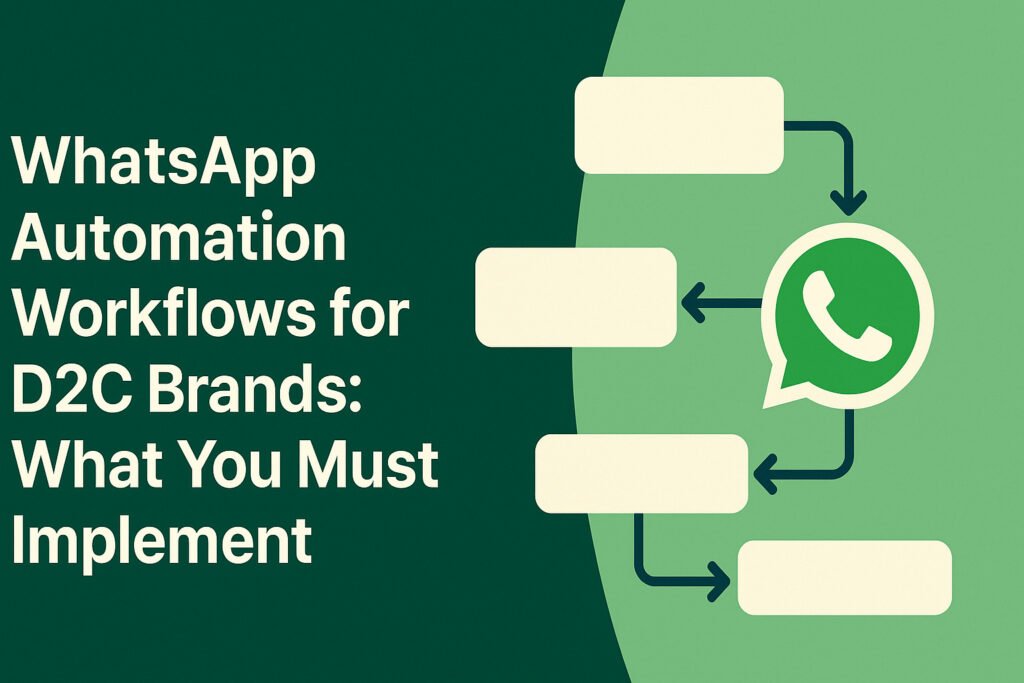
WhatsApp Automation Workflows for D2C Brands: What You Must Implement Direct-to-consumer (D2C) brands are constantly looking for new ways to increase customer engagement, drive conversions, and simplify operations. One of the most effective strategies to achieve all three is implementing WhatsApp automation workflows using the WhatsApp Business API. With the right workflows, your brand can respond faster, convert leads better, and create a more personalized shopping experience. In this blog, we explore the top WhatsApp automation workflows every D2C brand should use—and how TheBotMode can help you implement them effortlessly. 1. Welcome Message Workflow When a new customer messages your business or opts in via a landing page or ad, an automated welcome message builds instant connection. This workflow can: Why it matters: It creates a warm first impression and improves chances of conversion. 2. Abandoned Cart Reminder Workflow Many customers add products to cart but leave without purchasing. With WhatsApp automation, you can send personalized abandoned cart reminders to re-engage them. What to include: Why it matters: It helps recover lost sales and boosts revenue. 3. Order Confirmation and Shipping Updates Keep customers informed with real-time order updates: Why it matters: It reduces customer anxiety and support queries. 4. COD to Prepaid Conversion Workflow Cash on Delivery (COD) leads to high Return-to-Origin (RTO) rates. WhatsApp can help you nudge COD buyers to convert to prepaid using automation. How it works: Why it matters: Reduces RTO losses and improves cash flow. 5. Feedback and Review Collection Workflow After delivery, WhatsApp can be used to request a quick product review or feedback. You can ask: Why it matters: Social proof builds trust and improves product listings. 6. Reorder and Subscription Reminder Workflow If you sell products with repeat usage (like supplements, skincare, etc.), this workflow is crucial. Automate: Why it matters: It boosts customer retention and lifetime value. 7. Festival and Sale Campaigns Workflow Automate festive campaign workflows to notify customers during key sales: Why it matters: WhatsApp has higher open rates than email, making it perfect for time-sensitive promotions. 8. Customer Support Workflow (Auto-Reply + Live Agent Handoff) Use WhatsApp to provide 24×7 support with automated responses for FAQs and quick escalation to agents. Example: Why it matters: Reduces support load and improves customer satisfaction. How TheBotMode Simplifies WhatsApp Automation TheBotMode allows D2C brands to build, test, and optimize WhatsApp workflows with zero coding. With features like: You get everything you need to launch high-converting WhatsApp automation flows. FAQs Q1. Do I need coding knowledge to create WhatsApp automation workflows? No. With platforms like TheBotMode, you can build automation flows using a visual interface—no coding required. Q2. Can I send WhatsApp messages without customer opt-in? No. According to WhatsApp’s policy, businesses must collect customer opt-ins before initiating automated messages. Q3. How much does WhatsApp automation cost for a D2C brand? Costs vary depending on the platform and usage. TheBotMode offers affordable plans tailored for D2C businesses of all sizes. Q4. Is WhatsApp automation effective for small D2C brands? Yes. Even small brands can automate cart recovery, order updates, and customer support to increase efficiency and revenue. Q5. How do I measure the success of WhatsApp automation workflows? Track key metrics like open rates, click-through rates, conversions, and RTO reduction using TheBotMode’s analytics dashboard.
Boost First‑Time Orders with Spin the Wheel Coupons on WhatsApp
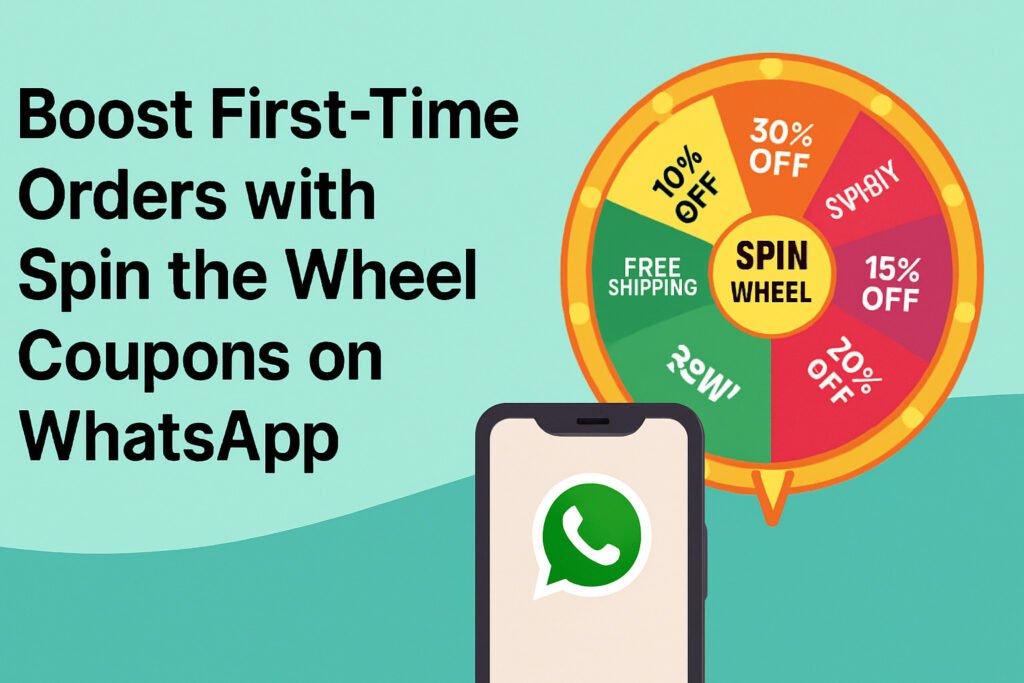
Introduction: Why First‑Time Orders Matter for D2C Brands For direct‑to‑consumer (D2C) businesses, converting new visitors into first‑time customers is often the most challenging and expensive phase of the funnel. Standard discount pop‑ups and static offers are frequently ignored. Enter Spin the Wheel gamification on WhatsApp—an interactive, engaging, and high‑conversion strategy that stands out. What Is Spin the Wheel for WhatsApp? Spin the Wheel is an interactive lead‑capture mechanism where users spin a virtual wheel to win a discount or reward. When integrated with WhatsApp automation through TheBotMode, this becomes a powerful system to convert first‑time visitors into buyers. Embed the widget on your website and deliver the winning coupon instantly via WhatsApp, creating a frictionless experience that builds trust and sparks action. Why Use Spin the Wheel Coupons on WhatsApp? 1. Higher Engagement Rates Gamified offers attract far more attention than static banners—users enjoy the interactive nature of spinning a wheel more than a standard discount notification. 2. Immediate Lead Capture To spin the wheel, visitors must submit their phone number. This enables you to grow a qualified, opted‑in list instantly and organically via WhatsApp. 3. Fast and Direct Coupon Delivery WhatsApp automation ensures personalized coupon codes land immediately in the user’s inbox—enhancing open rates and driving swift action. 4. Real‑Time FOMO Rewards Limited‑time coupons (e.g. valid for just 15–30 minutes) trigger urgency and prompt customers to act fast before the opportunity passes. How to Set Up Spin the Wheel Coupons with WhatsApp Step 1: Create Your Spin the Wheel Widget Use TheBotMode’s gamification plugin or a compatible third‑party widget. Configure the wheel with 3–5 reward tiers (e.g. 10%, 15%, 20% off or free shipping). Step 2: Connect It to WhatsApp Automation Integrate the widget using TheBotMode’s WhatsApp API. Once users enter their phone numbers and spin, the system triggers automated coupon delivery instantly. Step 3: Design Your WhatsApp Message Flow Structure your messaging effectively: Step 4: Follow Up with Reminder Flows If a coupon isn’t redeemed within hours or by the next day, automatically send reminder messages—perhaps with a “last chance” bonus to capture conversions. Best Practices for Spin the Wheel Campaigns Real Results: A D2C Skincare Brand Case Study A skincare brand implemented TheBotMode’s Spin the Wheel widget on their homepage, offering 10–30% off coupons via WhatsApp: This gamified approach transformed passive browsers into engaged buyers—delivering measurable uplift in acquisition and conversion. Conclusion: Make First‑Time Purchases Engaging and Seamless By combining Spin the Wheel gamification with WhatsApp automation, D2C brands can create engaging, seamless funnels that drive first‑time purchases. With TheBotMode, you can easily build, automate, and measure these campaigns—boosting conversions and growing your WhatsApp marketing list with qualified leads.













